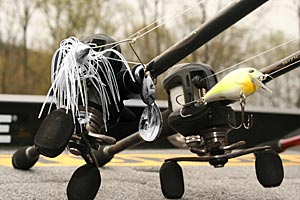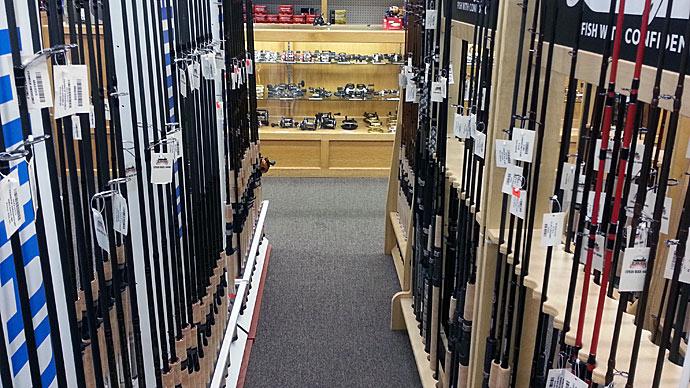
If there is ever a more anxious time among bass fishermen than the dead of winter, I don't know of it. Football is over, the lakes are frozen over, and the ponds are like a portrait of nature with snow drifting across the ice and cattails. Rather than driving around depressed or standing at the window looking at the inclement weather conditions, (all of which I have done) take a new approach - take this opportunity to GET READY for Spring.
Do the following: Remove all of your lures from their various boxes, tackle containers and hidden compartments on your boat, or float tube. Conduct an inventory of which ones require replacement, which ones require new hooks, eyes, and/or swivels. Be honest if ole' green eyes has caught many fish, but is beginning to be slow in the productive phase. Maybe a paint job, or retirement is the honest answer.
On the lures not requiring new hooks or hardware, check lips for cracks chips and/or tightness. Ensure the eyes of all crankbaits are secure, and without a space for the line to slip through.
Once you have laid everything out, conducted an inventory, and checked the tackle, sharpen or replace any and all hooks in question. Now you are involved in a project that will get you through 'til spring!
Review the inventory you have recorded, and you will be amazed at how many of the "favorite" lures, require some serious work, or duplicate lures to be purchased (see this can be fun). Nothing worse than to begin a successful fishing trip only to lose one of your "favorite" lures and realize you only have one; or to add insult to injury, you only have one with both treble hooks missing.
Next wipe out the boxes, and make a note of those that are past their life cycle - replace them. If a closure on the front of "Big Boy Tackle Box" is broken which, as you step into your boat, the cover hits you in the hand causing all of your secret tackle to dump into the lake before your very eyes, it will be a bad day. Just replace it. Doesn't matter how long you have had it, and that you are the only one that picks it up, and you know to lift on the left side as you pick it up, REPLACE IT.
Now that your tackle is inventoried, examined, sharpened, and painted or identified for replacement, put it back in some semblance of order in your boxes. For example organize the floaters from the sinkers from those that suspend. Go even further and mark the front of your drawers, (not those!) with a marker to identify each type. My brother even taught me to engrave the depth capability on the lip of each lure (especially those questionable.)
Now set this all aside, and get some coffee, don't turn this into work...
Once you return all motivated to continue, break out the poles one by one and prepare them for some serious examination. Start by removing the reels. Remove the line from the reels before you set them aside. I know you just put it on two months ago, but let's get serious. If you only hook into one trophy fish, or better yet, a state record fish, don't lose it over $7.00 worth of new line!
Now take each pole, and beginning at the top, check each eye for tightness, cracks in the material, and alignment with the remaining eyes. If you find one that is cracked, or missing the internal material, STOP! Set that pole aside; you are going to have to make a decision: 1. replace the defective eye, or 2. remove the pole from your inventory!
I recommend taking the pole to the local "reputable" sporting goods or fishing tackle supplier and have them replace the eye professionally. At that time, you might consider upgrading all of the eyes to something that is more durable.
During the examination of the eyes, be sure to look for grooves in the material, which makes that eye a candidate for replacement. IF you should find any pole that has only metal eyes, retire it, and move up to something that is not going to cut your line during that "special moment."
If the pole is multiple-piece pole make sure the pieces fit together smoothly and tightly. Make sure that you haven't inadvertently been fishing with a two different poles put together, this happens.
Now move down to the reel seat. The reel connection sleeve is the next item that needs to be looked at carefully. A friend of mine had a cracked sleeve on his pole, the reel fell off into the lake, the line snapped, and all I could do was stare at a culmination of failed equipment. Don't let that happen to you.
Move to the handles, and check the material, cork, rubber or whatever your pole is constructed of. Look for looseness, cracks, or anything that might fail. If you make one of your best over-hand casts, and the only thing left in your hand is the rubber sleeve while the pole lands twenty feet away in the lake, pardon me while I laugh. Been there done that.
Make a list of those poles requiring replacement, or back-up. Remember show this article to your wife to justify that every fisherman needs a baitcasting pole, a flipping pole, and a light tackle pole just to name a few, and of course, back-ups!
Set the poles and the list aside. Now take each reel with the line removed, and examine them for wear, looseness, or missing screws. Check the handles for straightness, and for ease of turning. The handles should spin around smoothly. There should only be the sound of the reel turning, not of the gears grinding or sounding dry.
Look at the reel for lubrication points, and lubricate sparingly. If the reel is to be used in extremely cold weather, I recommend using graphite instead of oil. The bail should move back and forth freely and without any noise. Tie a short piece of line to the reel and slowly tighten the reel as the handle is turned. Any sudden lock-up of the reel qualifies the reel for replacement.
Replace the line on the reels using the information on the side of the spools as a guide. Don't over fill, or your first cast will be disastrous, frustrating, and ruin your day. Don't under-fill your reel in the attempt to fill two spools with the spool of line; it will only cause the line to extend itself poorly during casting.
Choose your line according to your past experiences. If you normally fish in an area full of under water objects or sharp rocks, then you must fill your reels accordingly, and not expect ultra light line to perform acceptably. Don't load your reels with 20 lb test line if your favorite lake or pond is crystal clear, without much structure, and the largest fish to ever be removed from there is a 2 lb catfish caught 5 years ago by some Scout. Again, lack of line replacement is probably the number one cause of "big fish" losses. Dull hooks come in a close second, but usually no one can testify to the size of one lost due to dull hooks, because you never really felt it.
Examination of your boat and accessories are best left to the boat owners manual, but the above tackle and pole examination and care should help ensure some relaxing fishing days ahead. It is fun to hook into Mr. Big Mouth when you know your tackle is secure, the hooks are sharp, the line is new, and the drag is correctly set. Take a photo and release or contact your local Game and Fisheries Department about your trophy fish, I did!




